brown pelican is a bird of the pelican family
The brown pelican is the smallest of the eight extant pelican species, but is often one of the larger seabirds in their range nonetheless.[7][8] It measures 1 to 1.52 m (3 ft 3 in to 5 ft 0 in) in length and has a wingspan of 2.03 to 2.28 m (6 ft 8 in to 7 ft 6 in).[5] The weight of adults can range from 2 to 5 kg (4.4 to 11.0 lb), about half the weight of the other pelicans found in the Americas, the Peruvian and American white pelicans. The average weight in Florida of 47 females was 3.17 kg (7.0 lb), while that of 56 males was 3.7 kg (8.2 lb).[9][10][11] Like all pelicans, it has a very long bill, measuring 280 to 348 mm (11.0 to 13.7 in) in length.[5]
The nominate subspecies in its breeding plumage has a white head with a yellowish wash on the crown. The nape and neck are dark maroon–brown. The upper sides of the neck have white lines along the base of the gular pouch, and the lower foreneck has a pale yellowish patch. The feathers at the center of the nape are elongated, forming short, deep chestnut crest feathers. It has a silvery gray mantle, scapulars, and upperwing coverts (feathers on the upper side of the wings), with a brownish tinge. The lesser coverts have dark bases, which gives the leading edge of the wing a streaky appearance. The uppertail coverts (feathers above the tail) are silvery white at the center, forming pale streaks. The median (between the greater and the lesser coverts), primary (connected to the distal forelimb), secondary (connected to the ulna), and greater coverts (feathers of the outermost, largest, row of upperwing coverts) are blackish, with the primaries having white shafts and the secondaries having variable silver-gray fringes. The tertials (feathers arising in the brachial region) are silver-gray with a brownish tinge.[5] The underwing has grayish-brown remiges with white shafts to the outer primary feathers. The axillaries and covert feathers are dark, with a broad, silver–gray central area. The tail is dark gray with a variable silvery cast. The lower mandible is blackish, with a greenish-black gular pouch[12] at the bottom for draining water when it scoops out prey.[13] The breast and belly are dark,[14] and the legs and feet black.[12] It has a grayish white bill tinged with brown and intermixed with pale carmine spots.[12] The crest is short and pale reddish-brown in color. The back, rump, and tail are streaked with gray and dark brown, sometimes with a rusty hue.[12] The male and female are similar, but the female is slightly smaller.[5] It is exceptionally buoyant due to the internal air sacks beneath its skin and in its bones. It is as graceful in the air as it is clumsy on land.[15]
The nonbreeding adult has a white head and neck, and the pre-breeding adult has a creamy yellow head. The pink skin around the eyes becomes dull and gray in the non-breeding season. It lacks any red hue, and the pouch is strongly olivaceous ochre tinged and the legs are olivaceous gray to blackish-gray. It has pale blue to yellowish white irides which become brown during the breeding season. During courtship, the bill becomes pinkish red to pale orange, redder at the tip, and the pouch is blackish. Later in the breeding season the bill becomes pale ash-gray over most of the upper jaw and the basal third of the mandible.[5]
-
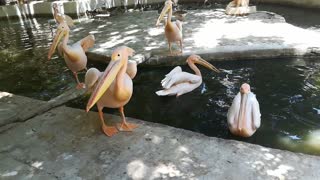 0:24
0:24
WorldZooAnimals
4 years agoFamily Pink Pelican Eats Little Boy Fishes
5 -
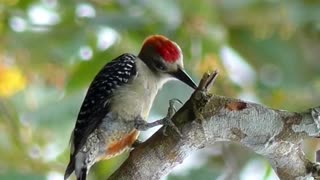 0:10
0:10
FourSeasons1
1 year agoRed Crowned Woodpecker bird
51 -
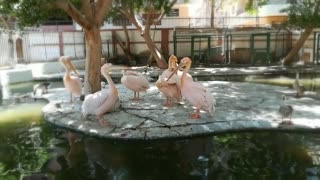 0:24
0:24
WorldZooAnimals
4 years agoGroup Meeting Pink Pelican Family
9 -
 1:32
1:32
Welcome to the World of Power Animals
6 months agoThe Pelican Power Animal
11 -
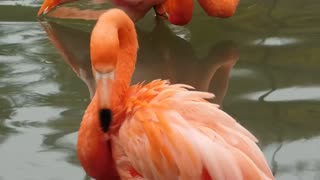 0:09
0:09
JASONFERRY
4 years ago $0.01 earnedOrange Flamingo Birds
478 -
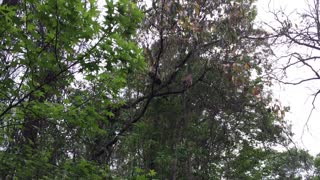 0:54
0:54
EFLORAROSS
6 years ago $0.01 earnedOwl Sizes Up Family Pet
891 -
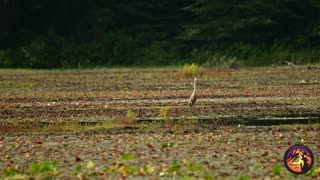 1:56
1:56
Adventure Joe Wildlife
1 year agoGreat Blue Heron
531 -
 8:47
8:47
TJAlex
2 years agoPeruvian Pelican birds at Vina Del Mar in Chile
5919 -
 0:18
0:18
Beautiful_Animals_And_Birds
5 years agoGorgeous Great white pelican 2
152 -
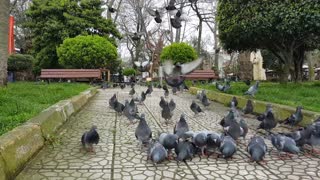 0:16
0:16
JASONFERRY
4 years agoAdorable Herd Of Gray Pigeon Bird
281